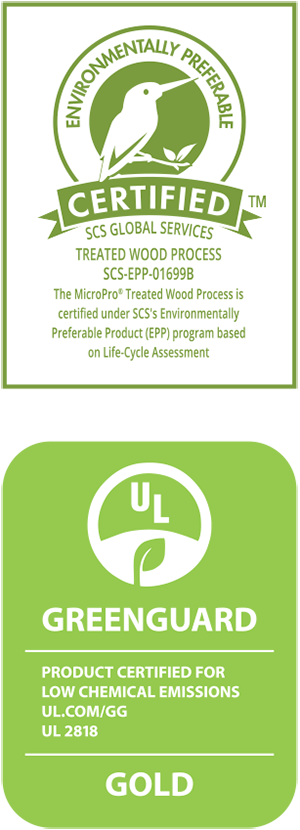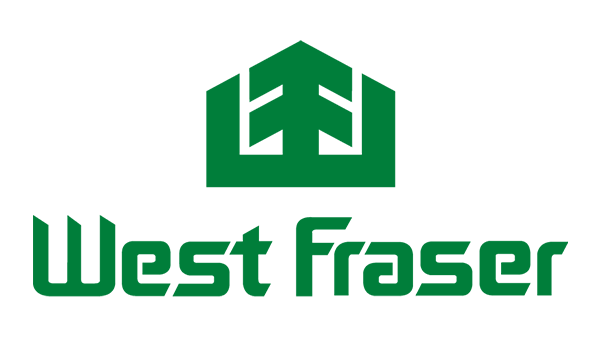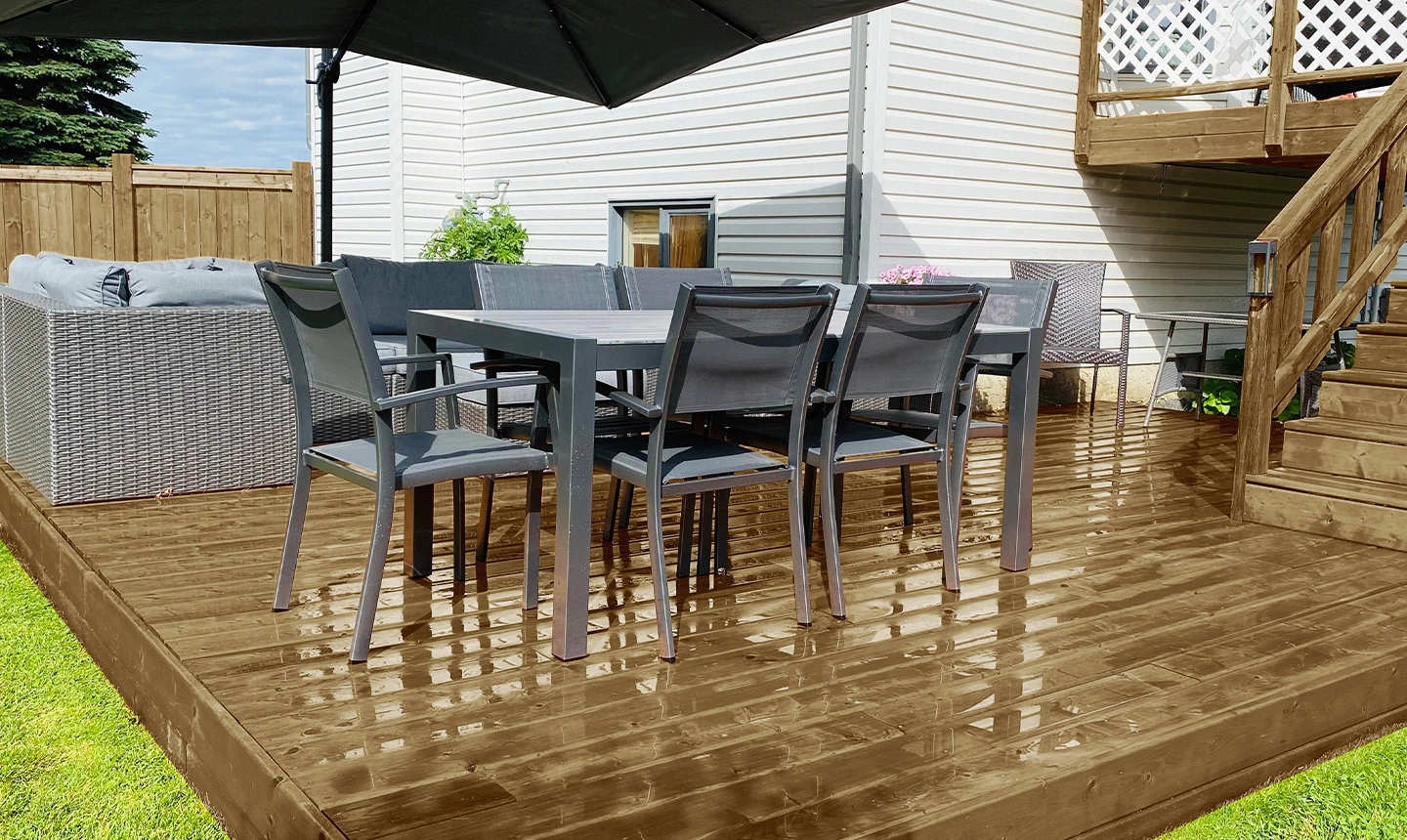West Fraser’s treating facilities use high-quality wood sourced directly from onsite or local sawmills.
HiLine Treated wood uses the most advanced wood treatment processes which makes it ideal for use in decks, fences, landscaping and general exterior construction uses. Our preservative technology meets Canadian Standards Association (CSA) as a wood preservative that has been formulated especially for Canadian species and use conditions. HiLine Treated wood can be used in residential applications above ground, in ground contact and in freshwater contact.
An all-round exterior wood product
HiLine Treated wood uses MicroPro® preservative technology which is the most advanced wood treatment process for wood used in decks, fences, landscaping and general exterior construction uses. MicroPro preservative technology meets Canadian Standards Association (CSA) standards as a wood preservative that has been formulated especially for Canadian species and use conditions. MicroPro Sienna Treated Wood can be used in residential applications above ground, in ground contact and in freshwater contact. Usage is indicated on the end tag attached to the treated lumber.
HiLine Treated wood is no more corrosive to metal products than untreated wood. Fasteners and hardware should be rated to the environment and conform to building codes. Aluminum building products may be placed in direct contact with HiLine Treated wood used indoors or in above ground exterior applications where the wood is not exposed to frequent and prolonged wetting, such as decks and fencing. (For more information, see the Fastener and Hardware Information sheet online.)
HiLine Treated wood products produced and used in Canada are backed by the MicroPro Sienna Residential Limited Warranty for first owners against structural failure caused by fungal decay or termites. (See warranty literature online for details.)
A positive choice for an eco-lifestyle
The MicroPro treated wood process was the first, and is the only, wood treatment process to be certified as an Environmentally Preferable Product (EPP) by Scientific Certification Systems (SCS), based on Life-Cycle Assessment.
- The MicroPro treated wood process was the first, and is the only, wood treatment process to be certified as an Environmentally Preferable Product (EPP) by Scientific Certification Systems (SCS), based on Life-Cycle Assessment.
- UL GREENGUARD GOLD Certification indicates that MicroPro preservative technology has undergone rigorous testing and has met stringent standards for low volatile organic compound (VOC) emissions. Products certified to this criteria are suitable for use in schools, offices, and other sensitive environments.

An attractive design alternative
HiLine Treated wood uses innovative micronized pigment technology to give the wood a warm natural brown tone that enhances its grain and natural characteristics. It offers a rich, finished look that complements today’s deck furniture and furnishings. Natural colour variations in the product are to be expected due to varying exposure conditions and the variation between different species of wood. In addition, colour variations may occur between heartwood and sapwood and knot areas from board to board or within the same piece of wood. We recommend that you make your selection of HiLine Treated wood from actual samples of the wood and that you inspect the product prior to installation for colour and other natural variations in the product.

It is possible that on some HiLine Treated wood a green colour may appear along the grain of the wood and around knots. Over time the green colour will soften and blend into the overall tone of the wood.
A colour-matched sealer for pressure treated wood, Cut-N-Seal® is available to cover cuts and holes above ground and to retouch any blemishes during construction of the project.
In an exterior project, the colour of HiLine Treated wood will turn to warm tan and over time will gradually transition to driftwood grey. The length of time will vary according to the exposure to sunlight, the wood species and the application. Long term, the initial colour will provide a good foundation for staining to renew or change the colour.
To maintain the colour and surface of HiLine Treated wood a high-quality water repellent or semi-transparent stain should be applied to the wood as soon as possible after construction of the project.
Unless the coating manufacturer stipulates otherwise, you can apply a stain or water repellent to the wood as soon as it is dry to the touch, which may be as soon as two weeks or as long as eight or more. It will depend on the weather, the exposure to sunlight and how wet the wood was when it was installed (it is saturated with water during pressure treatment). To test that the treated wood is surface dry, sprinkle water droplets on the surface. If the water droplets are absorbed into the wood, it is ready for stain. If not, try sprinkling again in a few days. Always read the finish product label and follow the manufacturer’s recommendations on how and when the product should be applied.
How Wood is Pressure Treated
For some western wood species, the treatment process differs due to incising needed for preservative penetration.
Pressure treatment is a process that forces wood preservatives or fire-retardants into the wood. These processes are considered the best and most effective method to extend and preserve timber life. Preservatives protect the wood from attack by wood ingesting insects; like termites, and wood rot caused by fungal decay. Fire-retardant treatments help the wood to quickly char when exposed to flame, reducing the smoke and flame that occurs in a fire.
Treated wood use applications include interior framing, exposed exterior wood for above ground or ground contact uses, fresh-water and salt-water exposures, and fire retardants for wall, roof and floor assemblies. Additionally, the pressure treatment process is used to protect utility poles, railroad ties, structural framing, fence pickets, deck boards, and posts.
A treatment facility obtains regionally specific wood such as Spruce, Fir or Pine for pressure treatments.
Pressure treating wood provides deep penetration and retention of preservatives for uniform protection for wood products, ensuring the treatment formulation meets the appropriate wood standards and building code requirements. With today’s advanced formulations, the treating process is very effective and computer controlled.
- Wood is ordered and shipped to the treating plant from regionally sourced mills.
- Wood is checked for moisture content to ensure the moisture is not too high to accept the preservative treatment.
- The pressure-treating process starts when forklifts place the wood on a tram that will move the wood into a large steel cylinder; called a vacuum pressure vessel.
- Once the wood is loaded into the cylinder, the doors are closed and the cylinder is sealed.
- An industrial vacuum pump removes air from the cylinder, and that includes pulling air out of the wood too.
- The cylinder is then flooded with the preservative solution.
- Pressure is applied to the solution in order to force the preservatives deep into the wood cells.
- Cycle times and pressure settings are adjusted based on the retention levels needed and the species of the wood being treated.
- Once the cycle has been completed, the cylinder is drained, then the industrial vacuum pump removes excess solution from the wood which is returned back to the work solution storage tank.
- A final vacuum is run within the cylinder to extract excess preservative which is returned back to the work solution storage tank.
- The door is opened, and the wood is removed. The freshly treated wood is then placed on a drip-pad for 24 to 48 hours.
- End tags are applied to every piece of lumber to denote producing Company, Chemical used, application, usage, safety information and contact number for consumer.
- The wood is now ready for loading and shipping to building supply and distribution companies.


